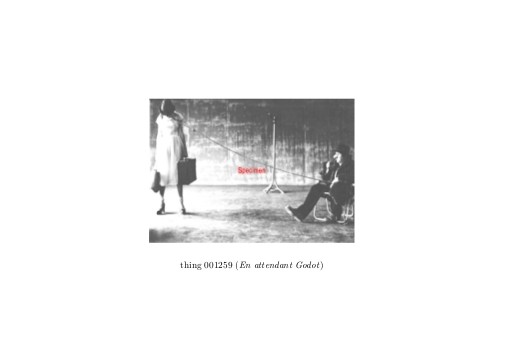Agency
28 Feb - 12 Apr 2015
AGENCY
Assembly (Before and After the Split Second Recorded)
28 February - 12 April 2015
The Gallery at REDCAT presents Assembly (Before and After the Split Second Recorded), a new exhibition by the Brussels-based initiative Agency, February 28 to April 12, 2015.
Founded by artist Kobe Matthys in 1992, Agency is compiling a growing list of ‘things’ that resist easy categorization between culture and nature, between man-made creations and facts, between subjects and objects, humans and non-humans, individuals and collectives. These things are derived from judicial proceedings, lawsuits, cases, or controversies regarding intellectual property (copyrights, patents, trade marks, etc). For the exhibition at REDCAT, Agency selected a series of cases from its list, posing a speculative query: “How can ephemeral things become included within art practices?”
The exhibition features a selection of ‘things’ from approximately 100 court cases available on shelves, with twenty openly displayed on tables at any given time. The controversies concern a range of practices from fine arts, gaming, music, reality television, sports, theater, etc. These cases will be shown in an almost forensic way, showing different elements related to the cases in order to bear witness.
Agency will convene a series of five public assemblies in the Gallery at REDCAT, to discuss the context of the controversy in question. Fragments of court decisions and related documents will be read, and reports will speculate on issues related to ephemeral practices in an open discussion. For each gathering around a particular case, a diverse group of Los Angeles’ concerned practitioners will be invited to contribute.
In order to qualify for copyright protection, an artwork must be “an original work of authorship fixed in a tangible medium of expression” and must exist in a form that is “sufficiently permanent or stable to permit it to be perceived, reproduced, or otherwise communicated for a period of more than transitory duration.” Many art practices fail to meet this requirement and a fixation would render their ephemeral aspects almost impossible to protect. These practices have been largely ignored in the past because of the difficulty of fixation, but with modern recording techniques, unscripted works became the new “frontier” for expanding the protection of works. In some instances the actual scope of intellectual property rights encompasses an infinite set of potential variations.
Assembly (Before and After the Split Second Recorded)
28 February - 12 April 2015
The Gallery at REDCAT presents Assembly (Before and After the Split Second Recorded), a new exhibition by the Brussels-based initiative Agency, February 28 to April 12, 2015.
Founded by artist Kobe Matthys in 1992, Agency is compiling a growing list of ‘things’ that resist easy categorization between culture and nature, between man-made creations and facts, between subjects and objects, humans and non-humans, individuals and collectives. These things are derived from judicial proceedings, lawsuits, cases, or controversies regarding intellectual property (copyrights, patents, trade marks, etc). For the exhibition at REDCAT, Agency selected a series of cases from its list, posing a speculative query: “How can ephemeral things become included within art practices?”
The exhibition features a selection of ‘things’ from approximately 100 court cases available on shelves, with twenty openly displayed on tables at any given time. The controversies concern a range of practices from fine arts, gaming, music, reality television, sports, theater, etc. These cases will be shown in an almost forensic way, showing different elements related to the cases in order to bear witness.
Agency will convene a series of five public assemblies in the Gallery at REDCAT, to discuss the context of the controversy in question. Fragments of court decisions and related documents will be read, and reports will speculate on issues related to ephemeral practices in an open discussion. For each gathering around a particular case, a diverse group of Los Angeles’ concerned practitioners will be invited to contribute.
In order to qualify for copyright protection, an artwork must be “an original work of authorship fixed in a tangible medium of expression” and must exist in a form that is “sufficiently permanent or stable to permit it to be perceived, reproduced, or otherwise communicated for a period of more than transitory duration.” Many art practices fail to meet this requirement and a fixation would render their ephemeral aspects almost impossible to protect. These practices have been largely ignored in the past because of the difficulty of fixation, but with modern recording techniques, unscripted works became the new “frontier” for expanding the protection of works. In some instances the actual scope of intellectual property rights encompasses an infinite set of potential variations.

